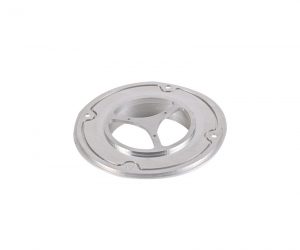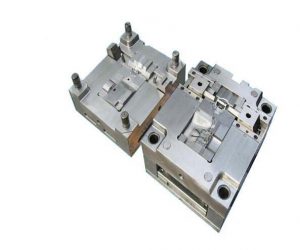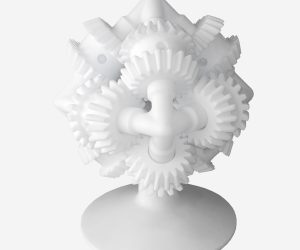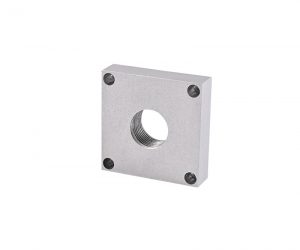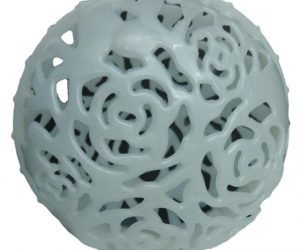The Colossus of Precision: Redefining Manufacturing Limits with Large CNC Machining. The realm of large-scale CNC machining transcends mere fabrication; it's a high-stakes choreography of engineering prowess, logistical dexterity, and unwavering commitment to quality. This intricate dance unfolds across diverse industrial landscapes, demanding a level of precision and sophistication previously unimaginable.
I. Beyond the Megaton: A New Era in Machining
A. The Genesis of Gigantic Precision: The landscape of modern manufacturing is undergoing a seismic shift. No longer constrained by the limitations of scale, a specialized niche—large CNC machining services—is emerging as a transformative force. These services wield colossal CNC machines, capable of sculpting components of previously unimaginable size and intricacy, pushing the boundaries of feasibility across diverse sectors, from the aerospace behemoths that pierce the stratosphere to the monumental structures that define our built environment.
B. An Indispensable Colossus: The impact of large CNC machining transcends mere technological advancement; it represents a fundamental paradigm shift. Industries facing the relentless pressure to produce larger, more complex, and exponentially more precise components find themselves inextricably reliant on these specialized providers. These are not merely suppliers; they are critical enablers of innovation, pushing the frontiers of what's possible in the pursuit of technological supremacy. The towering wind turbine nacelles harnessing the power of the wind, the intricate aerospace assemblies defying gravity—these are testaments to the transformative power of this burgeoning field.
II. Titans of Precision: The Machines Themselves
A. A Pantheon of Machining Gods: The heart of these operations lies in a diverse array of gargantuan machine tools, each a marvel of engineering prowess. These are not mere machines; they are precision instruments of monumental scale, capable of handling workpieces that dwarf conventional manufacturing capabilities. CNC mills, lathes, and specialized machining centers, boasting dimensions that defy the imagination and equipped with drives capable of exerting titanic forces, stand as testaments to human ingenuity. Their advanced control systems, operating with sub-micron accuracy, ensure unparalleled precision even on the grandest of scales.
B. Capabilities that Defy Description: The sheer scale and capabilities of these machines are breathtaking. Table sizes stretching across multiple meters, capable of accommodating workpieces weighing tens, even hundreds of tons, challenge the very definition of "machinable." These are not mere tools; they are industrial titans, purpose-built to conquer the most formidable manufacturing challenges. Advanced cutting tools, sophisticated probing systems providing real-time feedback, and comprehensive monitoring capabilities ensure uncompromising quality, even when dealing with components of unprecedented size and complexity.
III. The Algorithmic Crucible: Technologies and Techniques
A. Digital Alchemy: Software and Control Systems: The physical prowess of these machines is complemented by cutting-edge software and control systems, pushing the boundaries of what's computationally feasible. Advanced CAD/CAM applications, coupled with sophisticated numerical control programming, enable the creation of incredibly complex geometries. These systems are not merely tools for fabrication; they are the digital alchemists transforming raw materials into precision components, optimizing processes, enhancing quality control, and exceeding the most stringent specifications.
B. The Pursuit of Perfection: Innovations in Accuracy and Efficiency: The relentless pursuit of perfection drives constant innovation within this field. The integration of advanced sensor technologies, the implementation of real-time monitoring and adaptive control systems, and the deployment of sophisticated predictive maintenance algorithms—these are not incremental improvements; they are quantum leaps forward, pushing the limits of accuracy, speed, and overall production efficiency to unprecedented levels. The race for precision is not a sprint; it's an ongoing evolution, a testament to the enduring human quest for technological mastery.
IV. Industrial Titans: A Symphony of Scale and Precision
A. Aerospace and Defense: Forging the Future of Flight and Security: The aerospace and defense sectors represent the apex of large CNC machining's capabilities. These industries demand not merely components, but critical systems—the very sinews of next-generation aircraft and the lifeblood of advanced defense platforms. Failure is not an option; the tolerances are microscopic, the consequences catastrophic. The machining of these monumental parts necessitates a mastery of multi-axis milling, high-speed cutting, and advanced material science, pushing the boundaries of what's mechanically feasible.
B. Construction and Agriculture: Building the Infrastructure of Tomorrow: The colossal machinery that shapes our world—from earth-moving behemoths to towering cranes—owes its existence to the unwavering precision of large CNC machining. The intricate gearing, the robust load-bearing structures, the hydraulic systems—all are forged in the crucible of this technology. The demands here are equally stringent, demanding resistance to extreme stress, unwavering reliability in harsh environments, and a longevity that mirrors the infrastructure itself.
C. Energy and its Evolution: Powering a Sustainable Future: The energy sector, particularly the burgeoning renewable energy landscape, stands as a testament to the transformative potential of large CNC machining. The gargantuan nacelles of wind turbines, the intricate components of next-generation nuclear reactors—these are not merely parts; they are the engines of a global energy transition. The scale is immense, the precision unwavering, and the stakes are inextricably linked to the future of our planet.
V. The Guardians of Quality: Assuring Unwavering Performance
A. Standards and Certifications: A Bastion Against Compromise: In the high-stakes world of large CNC machining, adherence to stringent standards is not merely a suggestion; it's a non-negotiable imperative. Providers must navigate a complex web of industry-specific certifications and quality management systems (QMS), ensuring each monumental component meets—and often exceeds—the most demanding performance criteria. Deviation is unacceptable; the consequences resonate far beyond the individual part.
B. Integrated Quality Control: A Multi-Layered Defense: Quality control isn't a singular act; it's a continuous, multi-layered process. Advanced metrology, rigorous in-process inspection, and exhaustive final testing form an impenetrable shield against defects. The pursuit of perfection is not a mere aspiration; it's the bedrock upon which this industry is built.
VI. The Logistics of Giants: Transporting Titans with Unwavering Precision
A. Packaging and Shipping: A Symphony of Logistics: The sheer scale of these components presents unprecedented logistical challenges. Specialized packaging, bespoke handling equipment, and meticulous route planning are not optional; they are essential to ensure the safe transit of these colossal parts. A single mishap can unravel months, even years, of meticulous work.
B. On-site Handling and Installation: A Precise Ballet of Heavy Lifting: The journey doesn't end with delivery. On-site handling and installation require a delicate dance of heavy-duty cranes, specialized rigging, and coordinated assembly procedures. The integration of these precision-engineered components into the final system is a testament to human ingenuity and collaborative expertise.
VII. Sustainability and Eco-Efficiency: A Commitment to a Greener Future
A. Environmental Stewardship: Minimizing the Footprint of Giants: The industry is increasingly cognizant of its environmental impact. Large CNC machining providers are actively adopting energy-efficient processes, implementing waste reduction strategies, and prioritizing materials with a lower carbon footprint. Sustainability is not a peripheral concern; it's an integral part of the operational ethos.
B. Economic Viability: Balancing Precision with Profitability: The economic realities are as crucial as the environmental considerations. Providers must optimize processes, leverage technological advancements, and maintain rigorous quality control to deliver high-performance parts cost-effectively. The pursuit of profitability is not at odds with quality; it's a necessary component of long-term sustainability.
VIII. Future Perspectives: A Confluence of Technological and Market Forces
A. The Evolving Landscape of Gigantic CNC Machining: A Paradigm Shift
The realm of large-scale CNC machining is undergoing a period of unprecedented transformation, driven by a confluence of technological advancements and evolving market demands. The integration of additive manufacturing, no longer a mere adjunct but a potentially disruptive force, promises to redefine the very nature of component creation. Furthermore, the relentless march of automation, fueled by sophisticated robotics and AI-driven predictive maintenance, is poised to revolutionize production efficiency and precision. This convergence is not merely incremental; it represents a paradigm shift, pushing the boundaries of size, speed, and dimensional accuracy to previously unimaginable levels. The implications extend beyond mere efficiency gains; they encompass the creation of entirely new classes of components previously deemed impossible to manufacture.
B. Uncharted Territories: Growth Vectors and Market Dynamics
The insatiable appetite for larger, more intricate, and exquisitely precise components across diverse industries presents a fertile ground for expansion. The burgeoning renewable energy sector, with its demand for colossal wind turbine components and advanced solar infrastructure, stands as a prime example. Moreover, the aerospace and defense industries, perpetually striving for enhanced performance and operational reliability, continue to fuel the demand for exceptionally large and precisely engineered parts. This expansion, however, is not without its complexities. The emergence of new materials with unique machining characteristics, coupled with increasingly stringent regulatory requirements, necessitates continuous adaptation and innovation from service providers. The competitive landscape is therefore characterized by a dynamic interplay of technological prowess, strategic partnerships, and a relentless pursuit of operational excellence.
IX. Conclusion: The Architects of Industrial Progress
Large-scale CNC machining services are not merely manufacturers; they are the architects of industrial progress, enabling the creation of components that underpin advancements across a spectrum of sectors. Their mastery of colossal machine tools, coupled with their adeptness in harnessing cutting-edge digital technologies, positions them as indispensable partners in the realization of ambitious engineering feats. The commitment to rigorous quality assurance, the strategic navigation of complex logistical hurdles, and the growing emphasis on sustainable manufacturing practices collectively define the industry's enduring contribution. The future will undoubtedly witness an escalation in the scale and complexity of the components they produce, driving further innovation and solidifying their pivotal role in shaping the industrial landscape of tomorrow.
FAQs:
Q: What distinguishes large CNC machines from their smaller counterparts?
A: Large CNC machines are not simply scaled-up versions of their smaller brethren; they represent a distinct technological paradigm. Their capabilities extend far beyond mere size; they encompass the ability to handle workpieces of truly epic proportions – often weighing tens of tons and spanning several meters. This necessitates specialized structural design, advanced vibration damping systems, and sophisticated thermal management to maintain dimensional accuracy under extreme load conditions. The integration of advanced probing systems and real-time process monitoring ensures unparalleled precision, even at these monumental scales.
Q: How do large CNC machining service providers optimize their processes?
A: The optimization of large-scale CNC machining processes hinges on the seamless integration of advanced CAD/CAM software, sophisticated numerical control programming, and real-time data analytics. This allows for the precise simulation of machining operations, the identification of potential bottlenecks, and the implementation of corrective measures to minimize waste and maximize efficiency. Furthermore, the utilization of AI-driven predictive maintenance algorithms enables proactive identification and mitigation of potential equipment failures, minimizing downtime and enhancing overall productivity.
Q: Which industries rely heavily on large CNC machining services?
A: The reliance on large-scale CNC machining is pervasive across numerous high-value industries. Aerospace and defense, with their demand for exceptionally precise and robust components for aircraft, spacecraft, and military hardware, are prime examples. The energy sector, particularly renewable energy, relies on these services for the creation of massive wind turbine components and other critical infrastructure. Furthermore, the construction and agricultural equipment sectors depend on these services for the fabrication of large, durable components capable of withstanding extreme operating conditions.
Q: How is quality assurance maintained in large-scale CNC machining?
A: Quality assurance in large-scale CNC machining is not merely a process; it is a holistic philosophy. It begins with rigorous adherence to industry-specific certifications and quality management systems (e.g., ISO 9001). This is complemented by the implementation of comprehensive quality control measures throughout the entire manufacturing process, from raw material inspection to final component testing. The utilization of advanced metrology equipment ensures dimensional accuracy and conformance to stringent specifications. Traceability throughout the entire production chain is paramount, ensuring accountability and facilitating continuous improvement.
Q: What logistical challenges are involved in handling large components?
A: The transportation and handling of large, precision-machined components present unique logistical challenges. Specialized transport vehicles, often requiring permits and escort vehicles, are necessary. On-site handling requires heavy-duty lifting equipment, meticulous planning, and highly skilled personnel to prevent damage. The installation and integration of these components often necessitate the use of cranes, specialized rigging techniques, and precise alignment procedures. The entire process demands a high degree of coordination and expertise to ensure the safe and efficient delivery and integration of these monumental components.
